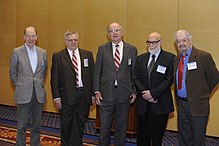Gerald Guralnik
Gerald Stanford Guralnik (born September 17, 1936 in Cedar Falls , Iowa , † April 26, 2014 in Providence , Rhode Island ) was an American theoretical physicist .
Career
Guralnik studied at the Massachusetts Institute of Technology ( bachelor's degree) and received his doctorate in 1964 from Harvard University (where he heard from, among others, Julian Schwinger ) with Walter Gilbert . From 1965 he was at the University of Rochester . He was later a professor at Brown University .
He became known for his work with Carl R. Hagen (whom he still knew as a fellow student at MIT and with whom he published when they were still students) and TWB Kibble on spontaneous symmetry breaking as a method of mass generation of vector bosons in Yang-Mills- Theories , an important basis of the electroweak interaction theory and the Standard Model . Peter Higgs , François Englert and Robert Brout also managed to do this independently . At the time of this work, Guralnik was a Post-Doc at Kibble at Imperial College as a Fellow of the National Science Foundation , and Hagen later joined. Although the work was independent and more complete than that of its competitors, the fact that Higgs (and Englert and Brout) published first meant that Higgs received much of the recognition (expressed in the name of the Higgs Mechanism ). In the mid-1960s, the theory itself was largely judged negatively, for example by Werner Heisenberg , when Guralnik presented it at a conference near Munich that he organized in 1965. In Guralnik's recollections, this was one reason he turned to other subjects, just as the electroweak unified theory was being developed by Steven Weinberg and Abdus Salam (who worked on it at Imperial College in part with John Clive Ward ) in the late 1960s .
He later worked on numerical algorithms in quantum field theory , among other things . In the 2000s he took part in a project to develop a computer with structures based on the model of the human brain ( Replacement Brain Project ).
He was a Sloan Research Fellow and a Fellow of the American Physical Society . In 1969/70 he was at the Institute for Advanced Study .
In 2010 he received the Sakurai Prize with Higgs, Englert, Brout, Hagen and Kibble.
Fonts
- The History of the Guralnik, Hagen and Kibble development of the Theory of Spontaneous Symmetry Breaking and Gauge Particles , 2009
- with CR Hagen, TWB Kibble: Global conservation laws and massless particles. In: Physical Review Letters. Volume 13, 1964, p. 585
- with T. Das, VS Mathur, Francis Low , JE Young Electromagnetic mass differences of pions , Phys. Rev. Lett., Volume 18, 1968, p. 759
- with Carl R. Hagen , F. Cooper Integral formulation of mean field perturbation theory , Annals of Physics, Volume 109, 1977, 165
- with F. Cooper, NJ Snyderman Is the Fermi theory of weak interactions a Yang-Mills-Theory in disguise? , Phys. Rev. Lett., Vol. 40, 1978, p. 1620
- with R. Gupta, G. Kilcup, A. Patel, S. Sharpe Weak interaction matrix elements with staggered fermions I: Theory and a trial run , Nuclear Physics B, Volume 286, 1987, p. 253
- with P. Emirdag, R. Easther, SC Hahn New numerical methods for quantum field theories on the continuum , Nucl. Phys. Proc. Suppl., 83, 2000, 938
- with DD Ferrante, J. Doll, D. Sabo Mollified Monte Carlo , Nucl. Phys. Proc. Suppl., Vol. 119, 2003, p. 965
- with J. Doll, R. Easther, P. Emirdag, DD Ferrante, S. Hahn, D. Petrov, D. Sabo Alternative numerical techniques , Nucl. Phys. Proc. Suppl., Volume 119, 2003, p. 950
- Gauge invariance and the Goldstone theorem, Lecture Feldafing 1965, Arxiv
literature
- TWB Kibble: Gerald Guralnik (1936-2014). In: Nature . Volume 510, No. 7503, 2014, p. 36, doi: 10.1038 / 510036a
Web links
Individual evidence
- ^ William Yardley: Gerald Guralnik, 77, a 'God Particle' Pioneer, Dies. In: The New York Times, May 3, 2014 (accessed May 4, 2014).
- ↑ Guralnik, Hagen, Kibble: Global conservation laws and massless particles. In: Physical Review Letters. Volume 13, 1964, p. 585
- ↑ Higgs: Broken symmetries, massless particles and gauge fields. In: Physics Letters. Vol. 12, 1964, p. 132; Higgs: Broken symmetries and the masses of gauge bosons. In: Physical Review Letters. Volume 13, 1964, p. 508.
- ^ Englert, Brout: Broken symmetry and the mass of gauge vector mesons. In: Physical Review Letters. Volume 13, 1964, p. 321.
- ↑ culminating in the urgent advice of his superior in Rochester Robert Marshak to change the research field
- ↑ Guralnik remembers that he wanted to start a discussion of their work with Ward at the time, but Ward blocked this by saying that Guralnik should be careful what he told other scientists from unpublished work. In retrospect, Guralnik saw this as a missed opportunity.
| personal data | |
|---|---|
| SURNAME | Guralnik, Gerald |
| ALTERNATIVE NAMES | Guralnik, Gerald Stanford (full name) |
| BRIEF DESCRIPTION | American physicist |
| DATE OF BIRTH | September 17, 1936 |
| PLACE OF BIRTH | Cedar Falls , Iowa |
| DATE OF DEATH | April 26, 2014 |
| Place of death | Providence , Rhode Island |

